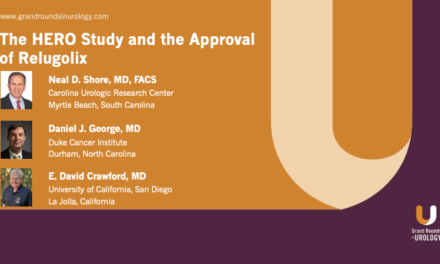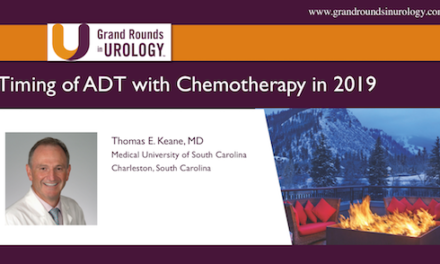Dr. Steven E. Finkelstein spoke at the 16th Future Directions in Urology Symposium on Monday, August 10, 2015, on “State of the Art Connection Between Immunotherapy and Radiation Therapy: Where We Are Now and Where We Are Going?”
Keywords: immunotherapy and radiation therapy
How to cite: Finkelstein, Steve E. “State of the Art Connection Between Immunotherapy and Radiation Therapy: Where We Are Now and Where We Are Going?” Grand Rounds in Urology. September 22, 2015. Accessed Nov 2024. https://dev.grandroundsinurology.com/connection-between-immunotherapy-radiation-therapy.
Transcript
State of the Art Connection Between Immunotherapy and Radiation Therapy: Where We Are Now and Where We Are Going?
It’s a pleasure to be here to speak today about the state-of-the-art connection between immunotherapy radiation therapy, where are we now, and where are we going. It’s a little different than some of the topics that we’ve talked about today.
As many of you know, I took the helm of 21st Century Oncology’s research about four years ago, built the TRC, the Translational Research Consortium, where our mission is to build novel approaches combining radiation therapy and other therapies to elicit radiation-induced personalized systemic therapy.
My journey has been an interesting one to date. As many of you know I did general surgery, then surgical oncology and immunotherapy at the National Cancer institute. I’m happy to say I’m alumni with Gomella over there.
This slide shows that I’ve aged visibly since you can see this young pup here on the left who has more hair although not everyone in my group has had more hair over time.
Our group was very productive looking to build immunotherapies for cancer going from the bench to bedside and back again. You can see here we have a track record of numerous publications of which we were able in vivo models to not only cause regression of large established tumors, something that in the surgery branch we had tried for 25 years to accomplish within the same models using a tripartite three component system of immunotherapy coupled with a vaccine approach, adoptive cell transfer, and an immune stimulator coupled with radiation therapy. Indeed these tumors not only went away but in a melanoma model they went after not only the melanoma, but since there’s melanoma differentiation antigens in the coat would actually have these animals have vitiligo and turn white.
Back in 2003 we published that using an advanced transgenic model in which we could tag T cells were able to show in this model the infiltrate of T cells using that approach. Those T cells were CD8 positive T cells. Indeed when we looked at the same in humans, this we published in PNAS we were able to achieve similar outcomes.
My journey was interesting. I was a dumb surgeon, right? I knew nothing about radiation so with Steve’s blessing I went back to school after ten years of doing surgical oncology and immunotherapy to get boarded in radiation oncology. The classic teaching for radiation oncologists is that you should never do radiation with immunotherapy. Radiation is immunosuppressive. We use it for bone marrow transplants but that’s when we give whole body not we do 99.9% of the work which is focal radiation therapy. Classic teaching suggests that radiation works through double stranded DNA breaks. However, that’s not the whole story.
We’ve known as immunologists, as surgeons that the immune system is important in the interaction that causes regression of cancer. There’s upregulation of various molecules such as Mac Class 1 and Class 2 enhancement of androgenic presentation of dendritic cells and when we radiate things what we actually do is not only hurt the cancer but cause danger signals, so-called DAMPs, damaged associated molecular patterns. Through this mechanism we can induce the expression of cytokines, chemokines, and inflammatory mediators, so when we think of what actually happens when we radiate things it’s probably not just DNA damage, which made a good story 60 years ago and made us a modality but this, which we published back in 2011, with Bob Timmerman who created stereotactic body radiation therapy, of which when you radiate things you get upregulation of class one molecules, adhesion molecules, costimulatory molecules, heat shock proteins, inflammatory mediators, immunomodulatory cytokines, and death receptors. This manuscript trended as the number one manuscript in radiation oncology for three months back in 2011. This was before people were talking about PD-1 and checkpoint inhibitors. I was lucky enough at NCI to be one of the first to give Yervoy before it was Yervoy, when it was Medarex’s compound.
We want to go from bench to bedside to bring immunotherapy into the clinic in relevant ways. When I had my fellow review the manuscripts that had been done about combining immunotherapy and radiation two, three years ago there weren’t that many. In 2014 when I had them write this, I’m happy obviously some of my papers are here, but we need to have more studies done. This was one of the first manuscripts in prostate cancer, an analogous manuscript in sarcoma. When you look histologically, when you have gigantic tumors growing, this is a sarcoma model, in vivo in humans, when you have gigantic tumors growing you actually look immunologically with respect to their histology you don’t see an influx of CD3 positive cells, T cells et cetera. However, with radiation coupled with immunotherapy you can see CD3 positive T cells. I’m a T cell chauvinist. I showed you that mouse model which that influx with CD8s actually here its CD4s so depending on how you elicit immunotherapeutic effects you may get very different responses immunologically.
We want to go from the bench to bedside and back again to build clinical opportunities to combine immunotherapy with radiation. My group is 21st Century Oncology. We’ve coupled with TGen, Jeff Trent’s group, to build an approach to do animal work that mimics what we do in the clinic. TD2 which is the drug development arm of TGen and 21st Century teamed up for rapid testing of anti-cancer drugs as combined with radiation therapy. 21Cs footprint is quite large with over 500 sites and 700 physicians.
We built ARIEL, the animal radiation imaging immunotherapy experimental lab which harbors a SARRP unit which at the time when we put in we were one of six units in the U.S. This facility is that same facility which we share with Dan VonHoof from U.S. Oncology.
You ever see a SARRP unit? I’m going to show you what it looks like. This is my head physicist and my head therapist. The unit behind it is a SARRP unit. It is essentially a shielded unit which mimics what we do in clinical radiation. You image as you would so animals go on the table like we put people on. We call that a couch. I have no idea. As a surgeon who became a radiation oncologist I still don’t know why we call it a couch. It’s a table.
We can image using CT scan, find the spot we want to treat, and then have clinically relevant setup and treatment of which we aim beams of energy where we want to. Here’s a subcutaneous model.
For those in the audience wanting to test relevant agents before they get to the clinic this is an approach which we believe has incredible utility remembering that we are a private practice group who has an advanced animal imaging laboratory.
Clinical trials in the clinic. Again, when you look at the panel of trials that are in Clinical Trials dot gov there is an infinite number. I’m happy to report that at least there are some trials combining radiation and immunotherapy currently as this is one of the hottest areas in the field.
I’m going to show you what is the largest immune monitoring trial to date. We wrote a trial to combine what is clinically available radiation with what is clinically available Provenge. Obviously I don’t need to teach this group about prostate cancer. We know in men with recurrent diseases androgen deprivation is the current standard. Until recently docetaxel was the only therapy that existed. Our research hypothesis that radiation in combination with Provenge may improve outcomes.
Provenge is essentially an autologous cellular immunotherapy. It’s pretty much analogous to adoptive cell transfer. We wrote about this and where we thought this was going back in 2011.
Provenge was approved based on seminal works. There were multiple trials that showed Provenge’s efficacy leading to the IMPACT trial which showed a 22.5% reduction in the risk of death with an improvement in median survival. I’m not going to debate the nuances of Provenge but Provenge is the clinically available treatment with immunotherapy for prostate cancer. PD-1 is not. Yervoy is not. However, those things when coupled to adoptive cell transfer approaches may yield very interesting utility if coupled with things like radiation in the right way.
Obviously Provenge was tested and very safe. Now radiation, as I talked about, we believe involves DNA damage plus more. We believe the dying of the cells—remember when we radiate prostate cancer in some cases we do it over nine weeks. Name another therapy that you have nine weeks of treatment. When I was a surgeon I cut things out, it went into a bucket. Not very immunogenic. However you sit and you radiate something for nine weeks or you use a stereotactic approach in which you give big doses of energy in a short period of time your body is going to have a natural response to healing.
We call this in the past the abscopal effect. We’ve known about this for 60 years. I didn’t think this up. The abscopal effect is the idea that if you radiate over here, over here, somewhere over here the tumor goes away. How does that work? In the past we said we didn’t know but it’s probably and elicitation of immune responses.
This involves lymphocytes with a great deal of nuances and dendritic cells with a great deal of nuances. How are we going to test this? As I talked about on Saturday the fact that you could image prostate cancer is a key aspect now in the management of patients. As the last lecturer alluded to this is advancing. We used to have technetium 99 bone scans and CTs. Now we have better imaging that can actually tell us where sites of disease is. I don’t know if Bela is in the audience. Bela said radiation oncologists how do you sleep at night? You sleep at night because you can image where the sites of cancer are and then treat it.
Within this study we not only built immunologic monitoring before and after every step but advanced imaging which included sodium fluoride PET CT bone scans with a sensitivity specificity over 905 and next generation C-11 acetate PETs. For those of you who have heard the C-11 choline story out of Mayo this is C-11 but acetate. There are only three sites in the U.S. which have currently capacity to do such. What does that look like?
FAT and PET CTs image bone sites of disease and probably very well in the right hands of those who read it. However, it doesn’t image soft tissue sites of disease where C-11 acetate can come in. The future of radiation and surgery is both anatomy is destiny and if you could image sites of disease you should be able to effectively build the right therapy.
C-11 acetate was actually not a new thing. It was around in the eighties. C-11 acetate was built for cardiac imaging and then they found all these guys with prostate cancer. The problem is that you need two $12 million cyclotrons you have to make the agent and then basically deliver it within 30 minutes. Here’s what a C-11 acetate looks like. It can image both bone and soft tissue.
This study will assess the effects of radiation coupled with immunotherapy. It’s a multicenter trial to have enrollment of a hundred patients. They get immune monitoring and C-11 acetates and F18s before and after each step with long-term follow-up.
Inclusion criteria is nothing exciting, except essentially you got to be eligible for both radiation and Provenge. Exclusion criteria is like most immunotherapy trials. You can’t be on systemic immunosuppressives.
The endpoint is to compare immune stimulation in patients receiving radiation following 28 days of Provenge with secondary endpoint is to look at the imaging.
The primary endpoint is percentage of subjects who elicit a two-fold increase in peripheral immune responses and post-treatment time points. This is currently enrolled.
ABOUT THE AUTHOR
Steven E. Finkelstein, MD, FACRO, is a radiation oncologist with Florida Cancer Affiliates in Panama City, Florida. He has served as a Co-Chair on the NRG Immunotherapy Committee, Co-Chair of the 2018-2019 ACRO Scientific Program Committee, and Chair of the SWOG Radiation STG Committee. He currently serves on the Board of Chancellors for ACRO. Dr. Finkelstein has also served as National Director of Translational Research Consortium (TRC), the cutting-edge therapy arm of 21st Century Oncology in Scottsdale, Arizona. Inspired by his grandmother, a cancer patient, he became a dedicated cancer surgeon who found that radiation therapy could sometimes do for his patients what surgery could not. Dr. Finkelstein received his medical degree from the University of Michigan Medical School. He served a residency in General Surgery at Washington University in Saint Louis, Missouri, and was Chief Resident in Radiation Oncology at the Moffitt Cancer Center in Tampa, Florida. Dr. Finkelstein also served fellowships in Biologic Immunotherapy, Clinical Cancer, and Surgical Oncology at the Surgery Branch of the National Cancer Institute in Bethesda, Maryland. He is a member of the American College of Radiation Oncology, the American Medical Association, the American Society of Clinical Oncology, the American Society for Therapeutic Radiology and Oncology, the Radiological Society of North America, and the Radiation Therapy Oncology Group.





